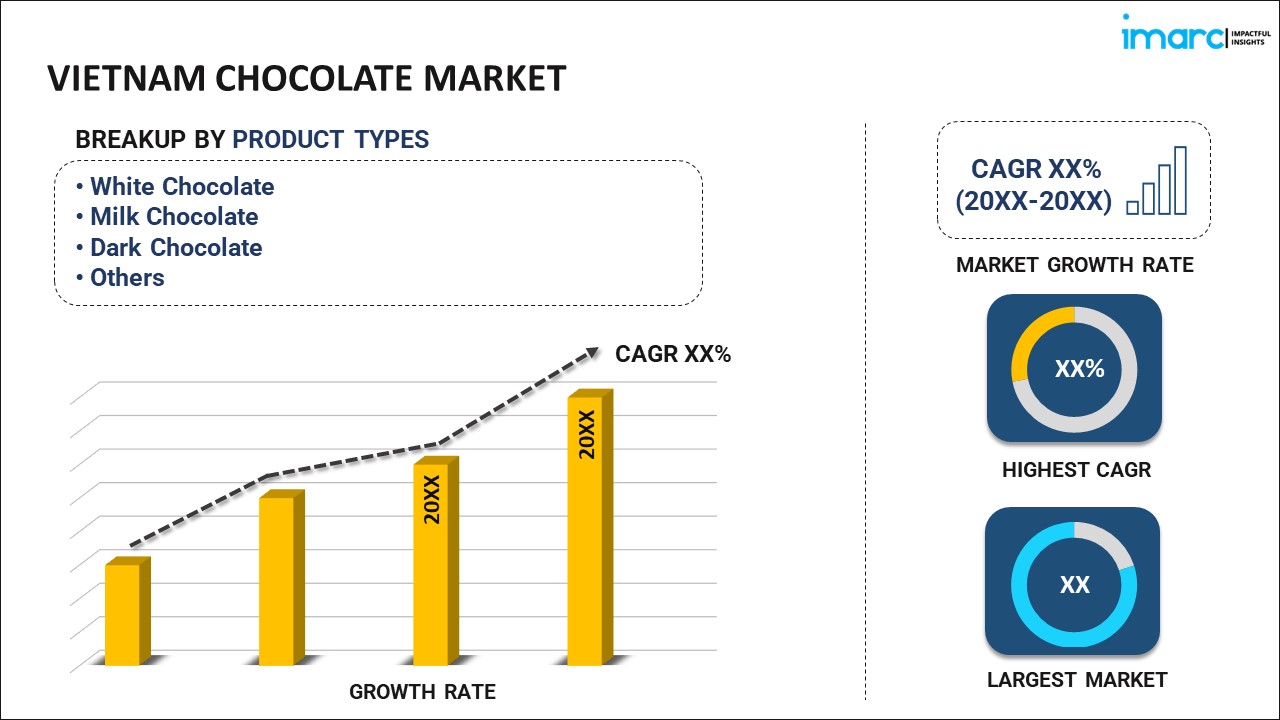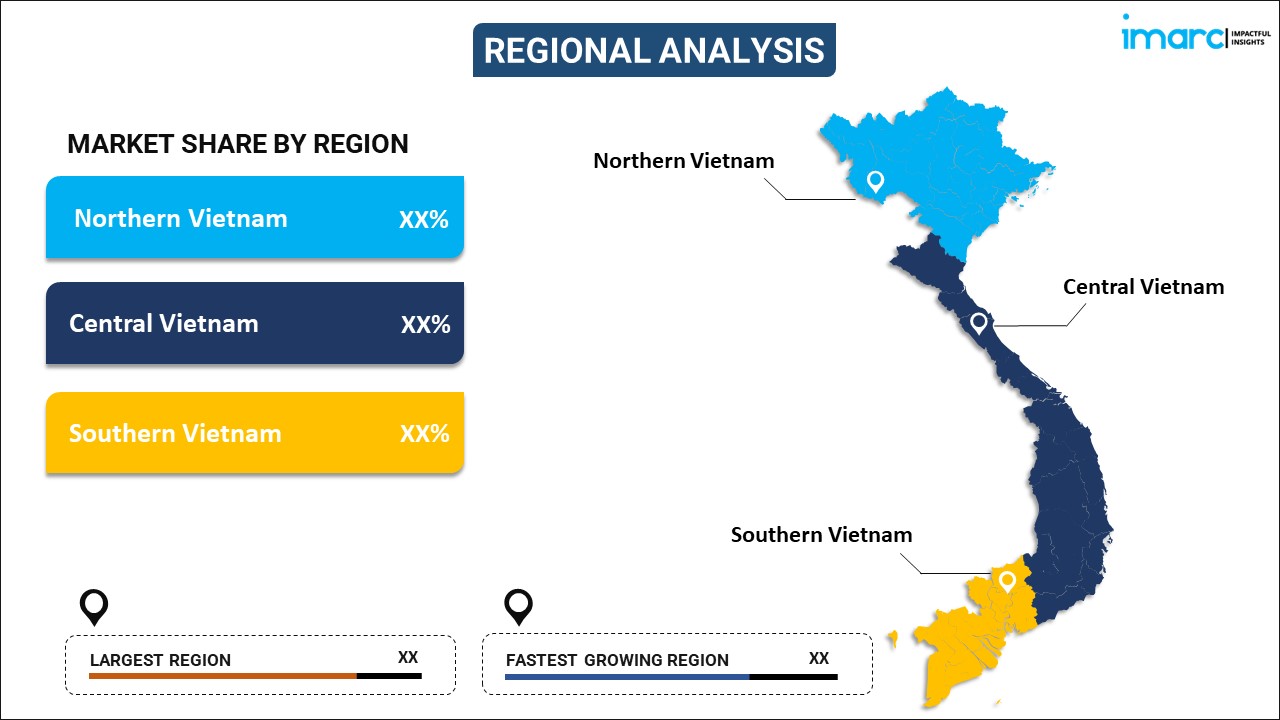
Vietnam Chocolate Market Report by Product Type (White Chocolate, Milk Chocolate, Dark Chocolate, and Others), Product Form (Molded, Countlines, and Others), Application (Food Products, Beverages, and Others), Pricing (Everyday Chocolate, Premium Chocolate, Seasonal Chocolate), Distribution (Direct Sales (B2B), Supermarkets and Hypermarkets, Convenience Stores, Online Stores, and Others), and Region 2025-2033
Market Overview:
Vietnam chocolate market size reached USD 842.1 Million in 2024. Looking forward, IMARC Group expects the market to reach USD 999.5 Million by 2033, exhibiting a growth rate (CAGR) of 2.1% during 2025-2033. The growing demand for high-quality and artisanal variants with ethically sourced ingredients, increasing advent of smart packaging with quick response (QR) codes and augmented reality (AR) elements, and rising number of e-commerce brands selling unique products represent some of the key factors contributing to the chocolate market share in Vietnam. In 2023, Vietnam shipped out USD 35.1 Million worth of chocolate, ranking 59th among 202 countries in global chocolate exports.
|
Report Attribute
|
Key Statistics
|
|---|---|
|
Base Year
|
2024
|
|
Forecast Years
|
2025-2033
|
|
Historical Years
|
2019-2024
|
| Market Size in 2024 | USD 842.1 Million |
| Market Forecast in 2033 | USD 999.5 Million |
| Market Growth Rate 2025-2033 | 2.1% |
Chocolate is a sweet edible component made from cacao beans, typically in the form of cocoa solids, cocoa butter, sugar, and milk solids. It comprises high cocoa content, minimal sugar and dark chocolate, which is known for its deep, intense flavor and potential health benefits. It also consists of milk chocolate, which is creamy and sweet due to the presence of milk solids. It includes ruby chocolate, which has a natural pink hue and a unique berry-like flavor. It exhibits a wide range of flavors, which depend on the cacao content and the presence of other ingredients. It can be smooth or have a velvet-like texture like a truffle or crunchy. Chocolate is rich in antioxidants, such as flavonoids, which may have health benefits like improving heart health and reducing inflammation. It contains compounds that may trigger the release of endorphins, promoting feelings of pleasure and reducing stress. It also contains caffeine, which can provide a quick energy boost. It is often incorporated with other ingredients like oats, dry fruits, and nuts to make energy bars.
Vietnam Chocolate Market Trends:
Premium and Craft Chocolates Seeing Strong Consumer Pull
Vietnamese consumers are showing growing interest in higher-end chocolate options. There's been a noticeable shift toward locally made artisanal chocolates that use single-origin cocoa beans, unique flavors, and minimal processing. These products appeal to a rising middle class with more disposable income and a taste for quality over quantity. Smaller brands are finding space by offering bean-to-bar experiences with transparent sourcing. This trend also ties into the broader appeal of healthier indulgence: less sugar, more natural ingredients, and a touch of authenticity. As the chocolate market in Vietnam matures, homegrown premium chocolate makers are gaining traction not only locally but also in exports.
Online Sales Channels Expanding Chocolate Access
Chocolate brands in Vietnam are leaning heavily into digital sales, and it's paying off. Online platforms, especially e-commerce giants and food delivery apps, have made it easier for people to buy chocolate from anywhere in the country. Social media and direct-to-consumer websites are also helping small businesses connect with younger shoppers who value convenience and fast delivery. Seasonal promotions, digital payment options, and targeted ads are driving up impulse purchases. Premium chocolate makers are finding opportunities to reach niche audiences without relying on supermarket shelf space. The Vietnam chocolate market size 2024 reflects this digital momentum with notable growth tied to online transactions.
Chocolate Tied to Travel and Local Gifting Habits
Domestic and international tourists often buy chocolate as a keepsake or gift, and this habit is influencing how brands present their products. Packaging now highlights local ingredients, cultural elements, or regional cocoa origins. Airports, resort shops, and tourist zones feature attractively boxed chocolates tailored for gifting. Vietnamese consumers are following suit, choosing chocolate as a gift for birthdays, Tet, and professional occasions. This growing gifting culture is driving demand for personalized, themed packaging and multiple pricing tiers. Brands are also aligning with Vietnam chocolate price trends to make gifting chocolates more accessible across budgets.
Cocoa-Based Drinks and Baked Goods Getting Popular
Cafes and bakeries across Vietnam are adding more cocoa-driven items to their menus. Hot chocolate, cocoa smoothies, chocolate tarts, and brownies are becoming favorites among young adults and urban families. Local and global chains are expanding their product lines to include more chocolate drinks and desserts, which are gaining popularity as comfort foods and casual treats. These habits are reshaping how chocolate is consumed beyond just bars and candy. The Vietnamese chocolate market is adapting to these patterns, and growth in this segment is driving more innovation across cafes, quick-service chains, and local bakeries.
Vietnam Chocolate Market Segmentation:
IMARC Group provides an analysis of the key trends in each segment of the market, along with forecasts at the country level for 2025-2033. Our report has categorized the market based on product type, product form, application, pricing, and distribution.
Product Type Insights:

To get more information on this market, Request Sample
- White Chocolate
- Milk Chocolate
- Dark Chocolate
- Others
The report has provided a detailed breakup and analysis of the market based on the product type. This includes white chocolate, milk chocolate, dark chocolate, and others.
Product Form Insights:
- Molded
- Countlines
- Others
A detailed breakup and analysis of the market based on the product form have also been provided in the report. This includes molded, countlines, and others.
Application Insights:
- Food Products
- Bakery Products
- Sugar Confectionary
- Desserts
- Others
- Beverages
- Others
The report has provided a detailed breakup and analysis of the market based on the application. This includes food products (bakery products, sugar confectionary, desserts, and others), beverages, and others.
Pricing Insights:
- Everyday Chocolate
- Premium Chocolate
- Seasonal Chocolate
A detailed breakup and analysis of the market based on the pricing have also been provided in the report. This includes everyday chocolate, premium chocolate, and seasonal chocolate.
Distribution Insights:
- Direct Sales (B2B)
- Supermarkets and Hypermarkets
- Convenience Stores
- Online Stores
- Others
The report has provided a detailed breakup and analysis of the market based on the distribution. This includes direct sales (B2B), supermarkets and hypermarkets, convenience stores, online stores, and others.
Regional Insights:

- Northern Vietnam
- Central Vietnam
- Southern Vietnam
The report has also provided a comprehensive analysis of all the major regional markets, which include Northern Vietnam, Central Vietnam, and Southern Vietnam.
Competitive Landscape:
The market research report has also provided a comprehensive analysis of the competitive landscape in the market. Competitive analysis such as market structure, key player positioning, top winning strategies, competitive dashboard, and company evaluation quadrant has been covered in the report. Also, detailed profiles of all major companies have been provided.
Vietnam Chocolate Market News:
- In July 2025, to mark World Chocolate Day, Maison Marou launched The Sô-cô-la Trail, a six-bar collection honoring Vietnamese cacao. Since opening in 2016, the brand has grown from Hồ Chí Minh City to six cities across Vietnam. Each location offers a full chocolate-making experience, strengthening Vietnam’s presence in the global craft chocolate scene and celebrating the country's single-origin cacao through premium, locally made products.
Vietnam Chocolate Market Report Coverage:
| Report Features | Details |
|---|---|
| Base Year of the Analysis | 2024 |
| Historical Period | 2019-2024 |
| Forecast Period | 2025-2033 |
| Units | Million USD |
| Scope of the Report | Exploration of Historical and Forecast Trends, Industry Catalysts and Challenges, Segment-Wise Historical and Predictive Market Assessment:
|
| Product Types Covered | White Chocolate, Milk Chocolate, Dark Chocolate, Others |
| Product Forms Covered | Molded, Countlines, Others |
| Applications Covered |
|
| Pricings Covered | Everyday Chocolate, Premium Chocolate, Seasonal Chocolate |
| Distributions Covered | Direct Sales (B2B), Supermarkets and Hypermarkets, Convenience Stores, Online Stores, Others |
| Regions Covered | Northern Vietnam, Central Vietnam, Southern Vietnam |
| Customization Scope | 10% Free Customization |
| Post-Sale Analyst Support | 10-12 Weeks |
| Delivery Format | PDF and Excel through Email (We can also provide the editable version of the report in PPT/Word format on special request) |
Key Benefits for Stakeholders:
- IMARC’s industry report offers a comprehensive quantitative analysis of various market segments, historical and current market trends, market forecasts, and dynamics of the Vietnam chocolate market from 2019-2033.
- The research report provides the latest information on the market drivers, challenges, and opportunities in the Vietnam chocolate market.
- Porter's five forces analysis assist stakeholders in assessing the impact of new entrants, competitive rivalry, supplier power, buyer power, and the threat of substitution. It helps stakeholders to analyze the level of competition within the Vietnam chocolate industry and its attractiveness.
- Competitive landscape allows stakeholders to understand their competitive environment and provides an insight into the current positions of key players in the market.
Key Questions Answered in This Report
The chocolate market in Vietnam reached USD 842.1 Million in 2024.
The Vietnam chocolate market is projected to exhibit a CAGR of 2.1% during 2025-2033, reaching USD 999.5 Million by 2033.
Increasing urbanization and middle-class disposable income, growing Western influence and desire for premium/imported chocolates, rising online and modern trade distribution, innovation in flavors and smart packaging (QR/AR), craft and artisanal brands, and volatile cocoa prices affecting affordability and production costs.
Need more help?
- Speak to our experienced analysts for insights on the current market scenarios.
- Include additional segments and countries to customize the report as per your requirement.
- Gain an unparalleled competitive advantage in your domain by understanding how to utilize the report and positively impacting your operations and revenue.
- For further assistance, please connect with our analysts.
 Request Customization
Request Customization
 Speak to an Analyst
Speak to an Analyst
 Request Brochure
Request Brochure
 Inquire Before Buying
Inquire Before Buying




.webp)




.webp)












